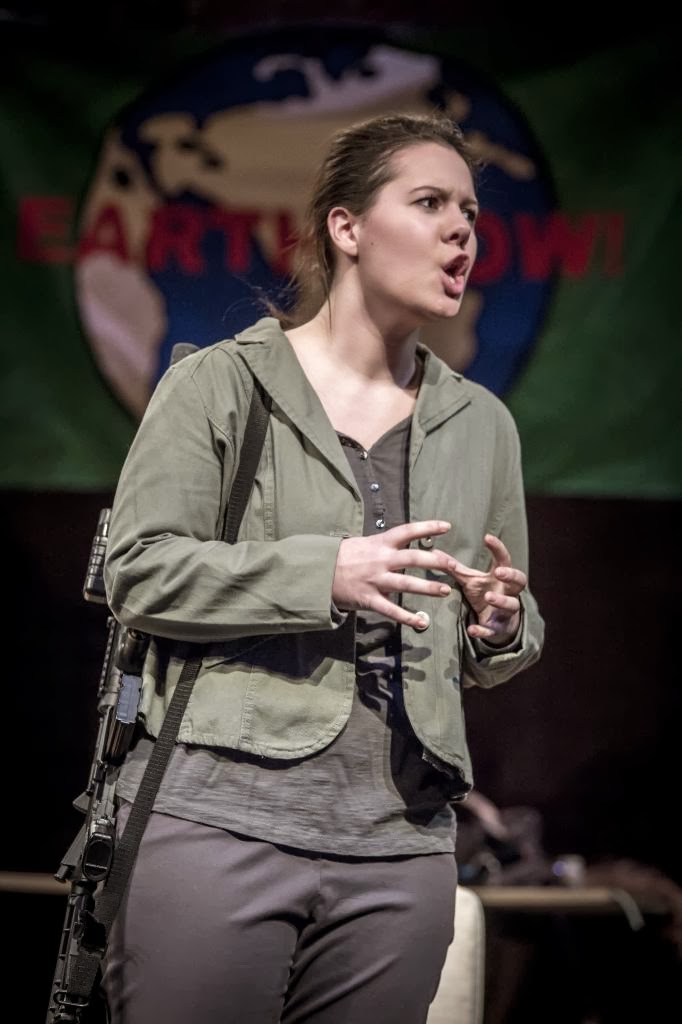All That Remains
By Tom Wachunas
“I have to become a good person on my own.”
–Anne Frank
For a few days prior to seeing the current
production The Diary of Anne Frank at
the Players Guild Theatre, I struggled with compassion fatigue. Maybe it’s the
ceaseless misery of this winter we’re having, translated into cold cynicism.
Not to minimize the staggering scale of Nazi atrocities during World War II…but
why should I want to revisit such a story as this one, as iconic as it is, when
our world is so saturated now with
stories of unspeakable human suffering? But enough of my diary.
Directed here by
Tammie McKenzie, this is the 1997 adaptation by Wendy Kesselman that includes
diary excerpts deleted from the original 1947 book publication. And despite the
depressing inevitability of its tragic end, I left the theater with not only a
rekindled appreciation of its inspired examination of hope and dignity in the
face of horrific tribulation, but also truly captivated by the believable
performances from the cast. Impressive, too, is the authenticity of the set
designed by Joshua Erichsen (neither too dark nor claustrophobic) along with
sound (recorded street noises and periodic snippets of radio broadcasts) and
highly effective lighting designed by Scott Sutton.
Crammed into dowdy
living quarters never designed to accommodate eight people, the characters’
flaws and foibles emerge in fairly short order. John T. Green and Ruth Dubinsky
bring a down-to-earth grit to their roles as Mr. and Mrs. Van Daan, but even
their most acerbic bickering can’t blot out the love that binds them. And
speaking of love, Donald Frederick Curie turns in a remarkably textured
portrayal of the wizened dentist, Mr. Dussel. He glows when he speaks longingly
of his absent wife, and glowers at Anne’s cloying intrusions.
As Margot Frank
(Anne’s older sister), Tess Roholt is a poignant embodiment of fragility and
loneliness. There’s a similar quality in Marilyn Wells’ portrayal of the
mother, Edith Frank, though with a decidedly more rueful, somber edge.
At first, Liam
Roth in his role of the Van Daan’s son, Peter, is overly stilted. But he
becomes increasingly credible as a painfully shy 15 year-old who is easily
exasperated by Anne’s unbridled impishness. And as all of the characters grow a
little older, so he too matures. In the process he genuinely warms to an emboldened
Anne, and romance blossoms.
For all of his
commanding physical presence, Tom Bryant as the Frank family patriarch, Otto,
carries himself with an understandably weary demeanor, at times seeming stiff
and detached. That said, he nonetheless projects a tangible aura of leadership
tempered by authentic empathy and affection. In a particularly tender moment,
he thanks Anne for her exuberant embrace of being alive, saying to her, “You
showed me that I can escape.”
Escape. That’s
precisely how Anne, compellingly played here by Rebecca Yourko, manages to
remain so ebullient in her outlook. Yourko presents a convincing portrait of
emotional and psychological escape from futility and fear by holding on for
dear life to the possibility if not promise of a bright future. While her
irrepressible spunk can often be annoying to the rest of this moody community,
it’s nonetheless her primary defense against complete hopelessness, albeit for
just two years.
It’s fascinating to hear the youthful urgency
in her voice as she speaks her diary entries while peering out at the audience.
Some of those entries are especially disarming, as when she reveals her
disconnectedness from her mother, or the intense awareness of her burgeoning
sexuality that she compares to the onset of spring. Look out, Peter Van Daan,
here comes hormonal honesty.
‘Compassion
fatigue’…What was I thinking?! At the
end of the play, Bryant’s delivery of Otto’s final monologue is both numbing
and heartbreaking. One by one the overhead spot light on each of the eight
attic captives goes black as he reports their fates, leaving him standing
alone, looking down at Anne’s diary in his hands. “All that remains,” he says
solemnly.
All indeed. “I want
to go on living even after my death,” Anne Frank wrote, a desire ironically born
of her ceaseless commitment to living passionately in the short moment. Her
wish was granted, thanks to potent art such as this, and no doubt that we
remain not drained, but enlivened by her hope and honesty.
The Diary of Anne Frank, at Players
Guild Theatre, 1001 Market Aveue N., Canton. Shows THROUGH MARCH 9, Friday and
Saturday at 8 p.m., Sunday at 2 p.m. Tickets $25, 17 and younger $19, Seniors
$23. Box Office: 330-453-7617 www.playersguildtheatre.com


















